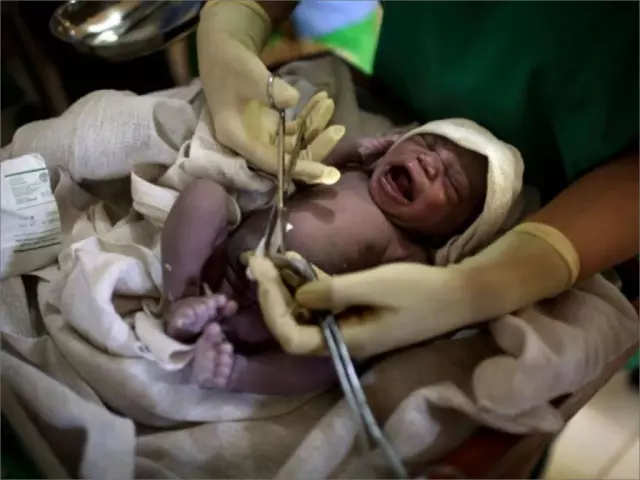- Author Rachel Wainwright [email protected].
- Public 2023-12-15 07:39.
- Last modified 2025-11-02 20:14.
Spinal cord
The spinal cord is a section of the central nervous system of the spine, which is a cord 45 cm long and 1 cm wide.

Spinal cord structure
The spinal cord is located in the spinal canal. Behind and in front are two grooves, through which the brain is divided into right and left halves. It is covered with three membranes: vascular, arachnoid and hard. The space between the vascular and arachnoid membranes is filled with cerebrospinal fluid.
In the center of the spinal cord, you can see a gray matter, cut in the shape of a butterfly. The gray matter consists of motor and intercalary neurons. The outer layer of the brain is the white matter of axons assembled in descending and ascending pathways.
In the gray matter, two types of horns are distinguished: the anterior, in which motor neurons are located, and the posterior, the location of the intercalary neurons.
In the structure of the spinal cord, there are 31 segments. From each stretch the anterior and posterior roots, which, merging, form the spinal nerve. When leaving the brain, the nerves immediately disintegrate into roots - the back and front. The dorsal roots are formed by the axons of afferent neurons and they are directed to the dorsal horns of the gray matter. At this point, they form synapses with efferent neurons, whose axons form the anterior roots of the spinal nerves.
In the posterior roots are the spinal nodes, in which the sensitive nerve cells are located.
The spinal canal runs along the center of the spinal cord. To the muscles of the head, lungs, heart, organs of the thoracic cavity and upper limbs, nerves depart from the segments of the upper thoracic and cervical parts of the brain. The abdominal and trunk muscles are controlled by the lumbar and thoracic segments. The muscles of the lower abdomen and the muscles of the lower extremities are controlled by the sacral and lower lumbar segments of the brain.
Spinal cord functions
Two main functions of the spinal cord are known:
- Conductor;
- Reflex.
The conductive function consists in the fact that nerve impulses move along the ascending paths of the brain to the brain, and commands are received along the descending paths from the brain to the working organs.
The reflex function of the spinal cord is that it allows performing the simplest reflexes (knee reflex, withdrawal of the hand, flexion and extension of the upper and lower extremities, etc.).
Only simple motor reflexes are carried out under the control of the spinal cord. All other movements, such as walking, running, etc., require the mandatory participation of the brain.
Spinal cord pathologies
Based on the causes of the pathologies of the spinal cord, three groups of its diseases can be distinguished:
- Malformations - postpartum or congenital abnormalities in the structure of the brain;
- Diseases caused by tumors, neuroinfections, spinal circulation disorders, hereditary diseases of the nervous system;
- Spinal cord injuries, which include bruises and fractures, compression, concussion, dislocation and hemorrhage. They can appear both independently and in combination with other factors.
Any diseases of the spinal cord have very serious consequences. A special type of disease includes spinal cord injuries, which, according to statistics, can be divided into three groups:
- Car accidents are the most common cause of spinal cord injury. Riding motorcycles is especially traumatic as there is no backrest to protect the spine.
- Falling from a height can be either accidental or deliberate. In any case, the risk of spinal cord injury is high. Often athletes, fans of extreme sports and jumping from a height are injured in this way.
- Domestic and extraordinary injuries. They often occur as a result of descending and falling in an unfortunate place, falling from a ladder or ice. Also, this group includes knife and bullet wounds and many other cases.
In spinal cord injuries, the conductive function is primarily disturbed, which leads to very disastrous consequences. So, for example, damage to the brain in the cervical spine leads to the fact that brain functions are preserved, but they lose connections with most organs and muscles of the body, which leads to paralysis of the body. The same disorders occur when peripheral nerves are damaged. If sensory nerves are damaged, sensation is impaired in certain areas of the body, and damage to motor nerves disrupts the movement of certain muscles.
Most nerves are mixed, and damage to them causes both inability to move and loss of sensation.
Spinal cord puncture
A lumbar puncture is the introduction of a special needle into the subarachnoid space. A puncture of the spinal cord is performed in special laboratories, where the patency of this organ is determined and the pressure of the cerebrospinal fluid is measured. The puncture is carried out for both therapeutic and diagnostic purposes. It allows you to timely diagnose the presence of hemorrhage and its intensity, find inflammatory processes in the meninges, determine the nature of a stroke, and determine changes in the nature of cerebrospinal fluid, signaling diseases of the central nervous system.
Puncture is often done to inject X-ray contrast and medicinal fluids.
For medicinal purposes, a puncture is performed in order to extract blood or purulent fluid, as well as for the introduction of antibiotics and antiseptics.
Indications for spinal cord puncture:
- Meningoencephalitis;
- Unexpected hemorrhages in the subarachnoid space due to ruptured aneurysm;
- Cysticercosis;
- Myelitis;
- Meningitis;
- Neurosyphilis;
- Traumatic brain injury;
- Liquorrhea;
- Echinococcosis.
Sometimes, during operations on the brain, spinal cord puncture is used to reduce the parameters of intracranial pressure, as well as to facilitate access to malignant neoplasms.
Found a mistake in the text? Select it and press Ctrl + Enter.






